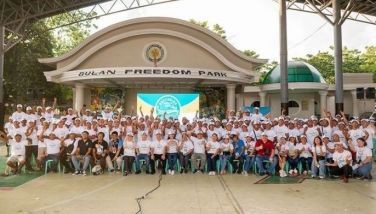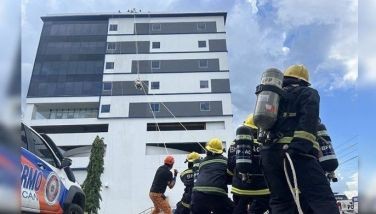Bataan and the 1946 Rescission Act
In the journey of life, we have two eyes that allow us to see the path ahead. We need a third eye to serve as a rear view mirror, providing us with a wide-angle perspective of the road being traveled and as English writer Dean Cavanagh put it, “In the land of the blind, the third-eyed man is king.”
* * *
Yesterday was the 80th anniversary of the fall of Bataan. On April 9, 1942, Major General Edward King Jr., commander of Philippine-American forces on the Bataan peninsula, surrendered to Japan’s 14th Army led by Lt. General Masaharu Homma. King’s forces consisted of 66,304 Filipinos and 11,706 Americans for a total of 78,010 troops. It was the largest US-led military capitulation in American history. By coincidence, it was on another 9th day of April in 1865 that General Robert E. Lee surrendered his Confederate armies to Union General Ulysses Grant, marking the end of the US Civil War.
Of the more than 78,000 troops that surrendered, some 10,000 would die during a long 100-kilometer Death March from Mariveles to San Fernando. Another 20,000 would perish due to disease, starvation, neglect and brutality while at the O’Donnell concentration camp in Capas, Tarlac. But perhaps what is less known to our people is that 350-400 Filipino officers and men of the 91st Philippine Army Division were murdered in cold blood by their captors after surrender. Known as the Pantingan River massacre, it remains the worst single atrocity to come out of the Bataan conflict.
One often wonders why we commemorate the fall of Bataan. It was a defeat, plain and simple, with the larger force yielding to a numerically smaller enemy army. We are probably the only nation on earth to highlight such a significant debacle. Uncle Sam prefers to forget the whole event, seeing it realistically as a humiliation for American military power, although a veteran’s organization in New Mexico holds an annual marathon to mark the day. Most Americans have no idea what Bataan was all about. Some connect it as the source of exotic rattan furniture from the east.
Perhaps to soften the blow, we have designated the day as “Araw ng Kagitingan” or Day of Valor. And we proclaim to the world that we are commemorating not a defeat but a victory of the spirit – the spirit of courage, of heroism and bravery by honoring the memory of the men and women who gave their lives in defense of our nation and the United States.
In November 2015, Rep. Gary Alejano and Rep. Francisco Acedillo, both young PMA graduates, filed House Bill no. 6242 designating Sept. 3, as the new Araw ng Kagitingan, to replace April 9. They called for a change in our mindset, urging us to remember our finest moments rather than one of our darkest hours. They believed that our nation’s military victories “carved by blood in the pages of history should be given respect and recognition.” According to the lawmakers, Sept. 3, 1896 was the day of the Battle of Imus, “the first big battle of the Philippine Revolution that the Filipinos won and Sept. 3, 1945 was the day General Tomoyuki Yamashita, commander of Japanese forces in the Philippines, surrendered at Camp John Hay in Baguio City.” It is time to listen to the voices of a new generation.
But as we continue to mark Araw ng Kagitingan in April, let me refresh our memories on the postwar experience of Filipino veterans who fought alongside US soldiers in Bataan. In July 1941, just before the start of the Pacific war, President Franklin Delano Roosevelt signed a directive calling on all military forces of the Philippine Commonwealth and ordering them into the service of the United States. As a Commonwealth of the United States, Filipinos were legally American nationals entitled to all the benefits afforded those serving in the armed forces of the United States.
Paradoxically, shortly after Japan surrendered, ending the war, the US Congress passed the “Rescission Act of 1946.” The Act provided that “service before July 1, 1946 in the organized military forces of the government of the commonwealth of the Philippines, while such forces were in the service of the armed forces of the United States... shall not be deemed to have been service in the military or naval forces of the United States... for the purpose of any law... conferring rights, privileges or benefits.” In short, there would be no privileges, no benefits for the Filipino veteran. As American historian Christopher Capozzola noted in his book “Bound by War:” “This was not America’s finest hour.”
These lines from Rudyard Kipling come to mind:
In times of war and not before
God and soldier we adore
But in times of peace and all things righted
God is forgotten and soldier slighted.
PS: In February 2009, 64 years after World War II ended, the US Congress passed the Recovery and Re-Investment Act of 2009. The legislation provided for a one-time, lump sum payment to Filipino veterans of World War II: $15,000 each for those who were US citizens, and $9,000 for non-US citizens. How many of our veterans passed away in those 64 years? Recently, Maj. General Antonio Taguba (US Army, ret.), chairman of the Filipino Veterans Recognition and Education project, called on the US Congress to act and repeal the Rescission Act of 1946, that would “repudiate the injustice these veterans have suffered for 75 years and to heal the indignation, pain and sorrow they endured over a lifetime.”
* * *
Email: rjfarolan56@gmail.com
- Latest
- Trending































